 |
 Published by the Township of Rideau Lakes M.H.A.C.
(Edition #5 - 2019)
Suggested time of walking tour 2 - 3 hours
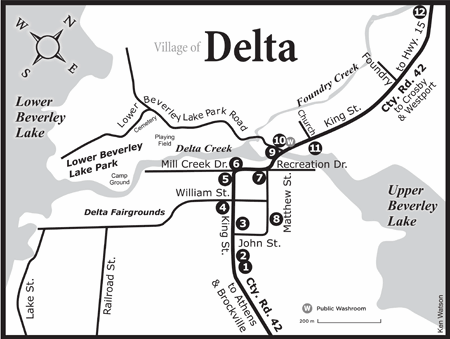 |
Name of Stop
12 = Hicock House, c.1845
11 = Johnston House
10 = Old Town Hall, 1879
9 = Old Stone Mill, c.1810
8 = Denaut House, 1849
7 = Delta Business Block, 1887
6 = Bell Store, late 1850s
5 = Bell House, 1860
4 = Copland House, 1892
3 = Brown House, 1905
2 = Stevens House, 1882
1 = Former Anglican Church, 1811 |
A Brief History
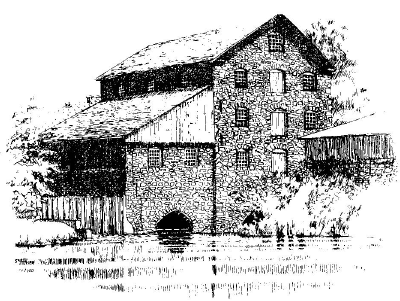 The year 1794 saw the first settlers in the Stevenstown area; settlers who came from Vermont with Elder Abel Stevens following the Revolutionary War. In 1796, Stevens was granted the land on which the community of Delta sits today. Delta’s ‘raison d’etre’ was a dam built on a local creek to power its mills, creating a single mill pond, Upper Beverley Lake, from what had previously been two smaller lakes. By the early 1800s, with its impressive 3 1/2 storey high stone mill, this community was a flourishing farming and industrial village. Over the decades, Delta became home to a growing number of pioneer trades and crafts including general stores, a variety of smiths, hotels, a tannery, distillery, brickyard, foundry, cheese factory, carriage works, a newspaper and among others services, even a hospital. Many of these early structures, the skills and talents they housed and the families they homed have been lost. But fortunately a significant number of buildings remain to illustrate the life of a busy and prosperous community. As well, many customs remain. For example, the annual Delta Fair is a thriving tradition dating back to 1830. The year 1794 saw the first settlers in the Stevenstown area; settlers who came from Vermont with Elder Abel Stevens following the Revolutionary War. In 1796, Stevens was granted the land on which the community of Delta sits today. Delta’s ‘raison d’etre’ was a dam built on a local creek to power its mills, creating a single mill pond, Upper Beverley Lake, from what had previously been two smaller lakes. By the early 1800s, with its impressive 3 1/2 storey high stone mill, this community was a flourishing farming and industrial village. Over the decades, Delta became home to a growing number of pioneer trades and crafts including general stores, a variety of smiths, hotels, a tannery, distillery, brickyard, foundry, cheese factory, carriage works, a newspaper and among others services, even a hospital. Many of these early structures, the skills and talents they housed and the families they homed have been lost. But fortunately a significant number of buildings remain to illustrate the life of a busy and prosperous community. As well, many customs remain. For example, the annual Delta Fair is a thriving tradition dating back to 1830.
The 20th and 21st centuries have brought many changes to Delta as to other communities across Eastern Ontario; a shift from an agricultural to a tourist economy, from a rural to an urban way of life. The Municipal Heritage Advisory Committee (M.H.A.C.) endeavours with this Heritage Tour of Delta to illustrate a variety of architectural influences reflected in the buildings of this colourful community. Amble casually with us on this tour. Imagine the ring of the mason’s hammer, the whripp of the carpenter’s saw, the humming of mills, the singing of choirs, the laughter and tears of family and village life as it was a century or two ago.
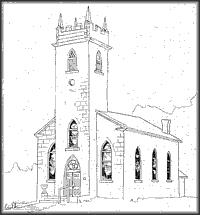 #1 - Former Anglican Church, 1811 - One of the oldest continuously-used churches in Ontario, this fine home of worship has served three denominations. The structure, erected by the Baptists in 1811, was used by them while the interior remained unfinished due to lack of funds. Legend has it that a bell, donated by a generous benefactor to call the devoted to worship was carried away by thieves. But the bell clanged its whereabouts to those in hot pursuit and it was retrieved, slightly cracked by this sinful experience. Hence it is off-key for eternity. #1 - Former Anglican Church, 1811 - One of the oldest continuously-used churches in Ontario, this fine home of worship has served three denominations. The structure, erected by the Baptists in 1811, was used by them while the interior remained unfinished due to lack of funds. Legend has it that a bell, donated by a generous benefactor to call the devoted to worship was carried away by thieves. But the bell clanged its whereabouts to those in hot pursuit and it was retrieved, slightly cracked by this sinful experience. Hence it is off-key for eternity.
In 1827, this building was purchased by the Anglicans and in a commendable example of early ecumenicalism, both congregations worshiped here for
many Sundays over many years. Indeed, the Methodists too, congregated here from 1843 – 1862. In 1864, the Baptists left to worship in their new church in Philipsville. They later built their own church in Delta, as did the Methodists. Constructed of fieldstone, now enhanced with stucco and paint, this fine edifice is a typical example of early church architecture in Canada. Note the Gothic windows and the crenellations on the tower, a reflection of medieval tradition. This beautiful and legendary place of worship no longer serves as an Anglican Church. In lieu, a dedicated committee of local residents pre- serves this focus of community services for notable events such as weddings, recitals and reunions.
 #2 - Stevens House, 1882 - This substantial red brick residence is representative of a successful businessman’s home in the 1880s. Alexander Stevens was the great-grandson of the founder of the community and he owned and operated the Delta Centennial Carriage Factory, a bustling business in pre-automobile decades. A flat section on the roof is surrounded
by attractive wrought iron trim. The segmental-headed windows were the latest thing in the 1870s and 80s shedding light into the residence of Alexander and Eliza Stevens. #2 - Stevens House, 1882 - This substantial red brick residence is representative of a successful businessman’s home in the 1880s. Alexander Stevens was the great-grandson of the founder of the community and he owned and operated the Delta Centennial Carriage Factory, a bustling business in pre-automobile decades. A flat section on the roof is surrounded
by attractive wrought iron trim. The segmental-headed windows were the latest thing in the 1870s and 80s shedding light into the residence of Alexander and Eliza Stevens.
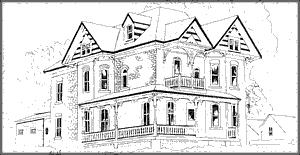 # 3 - Brown House, 1905 - Another prominent businessman, Omer Brown was a general merchant with his store located in the Jubilee Block (see #7). Omer and Leaffie Brown designed and constructed this grand residence with a variety of features of Queen Anne style. This elegant home embodies the Victorian love of variety, industry and excess. By the end of the 19th century, local factories were able to mass produce countless decorative designs in diverse media. Look for its unique features: the asymmetrical front door, the steeply-pitched roof broken by several cross gables of irregular shape and height, prominent bay windows, a single storey porch with second-storey balcony, spindle or turned railing posts and a façade textured with patterned shingles, decorative masonry and stained glass windows. # 3 - Brown House, 1905 - Another prominent businessman, Omer Brown was a general merchant with his store located in the Jubilee Block (see #7). Omer and Leaffie Brown designed and constructed this grand residence with a variety of features of Queen Anne style. This elegant home embodies the Victorian love of variety, industry and excess. By the end of the 19th century, local factories were able to mass produce countless decorative designs in diverse media. Look for its unique features: the asymmetrical front door, the steeply-pitched roof broken by several cross gables of irregular shape and height, prominent bay windows, a single storey porch with second-storey balcony, spindle or turned railing posts and a façade textured with patterned shingles, decorative masonry and stained glass windows.
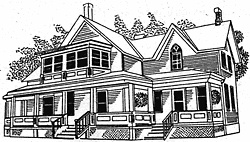 #4 - Copland House, 1892 -This spacious home of grand size and symmetry and boasting a grand veranda was built by Joel Copeland and family who operated a pharmacy in the Jubilee Block (see #7). It might be called the House of the Three Gables, the outer ones featuring pointed Gothic-style windows. Its shiplap siding reflects a time
when local forests were still abundant and local mills could make fine lumber. Perhaps even greater fame than its architecture is by association as it was
once the residence and office of Dr. Joseph Kelly, a truly legendary country doctor, famous among renowned peers. The stories are myriad of dedicated
hours, of late nights and of travels through harrowing conditions. Dr. Kelly, for several decades ministered to the physical and emotional well-being
of his devoted patients. In days long before modern antibiotics and MRIs, Dr. Joseph Kelly performed miracles with that greatest of all medicine, his
renowned sense of humour. #4 - Copland House, 1892 -This spacious home of grand size and symmetry and boasting a grand veranda was built by Joel Copeland and family who operated a pharmacy in the Jubilee Block (see #7). It might be called the House of the Three Gables, the outer ones featuring pointed Gothic-style windows. Its shiplap siding reflects a time
when local forests were still abundant and local mills could make fine lumber. Perhaps even greater fame than its architecture is by association as it was
once the residence and office of Dr. Joseph Kelly, a truly legendary country doctor, famous among renowned peers. The stories are myriad of dedicated
hours, of late nights and of travels through harrowing conditions. Dr. Kelly, for several decades ministered to the physical and emotional well-being
of his devoted patients. In days long before modern antibiotics and MRIs, Dr. Joseph Kelly performed miracles with that greatest of all medicine, his
renowned sense of humour.
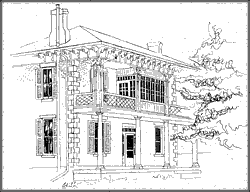 #5 - Bell House, 1860 - An Irish-born merchant, William Bell constructed this fine 2 storey red brick residence that manifests his business success in this thriving community during the mid-19th century. This elegant residence was formal, symmetrical and detailed in its Georgian style. One wonders if he drew upon the graceful homes of his native Eire to plan the Bell home in the New World. Note the stone quoins of the front façade, the fine brackets, wooden trim on the porch and its central doorway with multi-light transom and sidelights. On soft summer evenings, one might imagine the lilt of the cotillion at a fine gala hosted by the Bell family. #5 - Bell House, 1860 - An Irish-born merchant, William Bell constructed this fine 2 storey red brick residence that manifests his business success in this thriving community during the mid-19th century. This elegant residence was formal, symmetrical and detailed in its Georgian style. One wonders if he drew upon the graceful homes of his native Eire to plan the Bell home in the New World. Note the stone quoins of the front façade, the fine brackets, wooden trim on the porch and its central doorway with multi-light transom and sidelights. On soft summer evenings, one might imagine the lilt of the cotillion at a fine gala hosted by the Bell family.
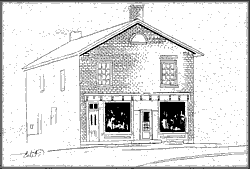 #6 - Bell Store, late 1850s - Constructed of locally-made brick, this building is typical of a mid-19th century combined store and residence. An elaborate wooden cornice stretches across the front façade above the large display windows. Incorporated into the cornice is a door leading to the living area above the store. Listen carefully
and imagine the sounds and smells of goods being loaded and unloaded at the back of the store. Treasures from the outer world, tea from India, fine
porcelain from Britain came by steam boat to Mr. Bell’s emporium via the Rideau Canal, Morton and Lower Beverley Lake. #6 - Bell Store, late 1850s - Constructed of locally-made brick, this building is typical of a mid-19th century combined store and residence. An elaborate wooden cornice stretches across the front façade above the large display windows. Incorporated into the cornice is a door leading to the living area above the store. Listen carefully
and imagine the sounds and smells of goods being loaded and unloaded at the back of the store. Treasures from the outer world, tea from India, fine
porcelain from Britain came by steam boat to Mr. Bell’s emporium via the Rideau Canal, Morton and Lower Beverley Lake.
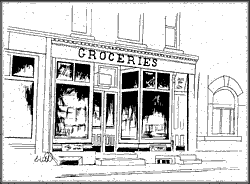 #7 - Delta Business Block, 1887 - Built to replace an earlier ‘shopping mall’ that was destroyed by fire the previous year, this “Jubilee Building” commemorated Queen Victoria’s Diamond Jubilee, the 60th anniver- sary of her accession to the throne. A century before malls became common fixtures in Canadian cities, Bill Birch’s one-stop shopping centre in
Delta retains many of its original features.You can still see the original series of shops with their large display windows that once hailed the latest in tin goods, fashions and Lifebuoy Soap. Notice the wooden cornice on the first façade and the wooden dentil work. The double doors and the interior tin ceilings also remain from an age of shopping basket instead of shopping cart. To the west of the Jubilee Building, you can see a red brick building that once served as a bank. To a skeptical populace, the massive semi-circular arched windows and door headings of the first floor façade manifest early 20th century ‘bank architecture’. Here was a secure haven for your hard-earned pennies. The community bank provided a leap-of-faith toward more security and reward for your spare cash than in a sock under your mattress. In our changing world, Delta’s Jubilee Building is seeking new identity in the 21st century. #7 - Delta Business Block, 1887 - Built to replace an earlier ‘shopping mall’ that was destroyed by fire the previous year, this “Jubilee Building” commemorated Queen Victoria’s Diamond Jubilee, the 60th anniver- sary of her accession to the throne. A century before malls became common fixtures in Canadian cities, Bill Birch’s one-stop shopping centre in
Delta retains many of its original features.You can still see the original series of shops with their large display windows that once hailed the latest in tin goods, fashions and Lifebuoy Soap. Notice the wooden cornice on the first façade and the wooden dentil work. The double doors and the interior tin ceilings also remain from an age of shopping basket instead of shopping cart. To the west of the Jubilee Building, you can see a red brick building that once served as a bank. To a skeptical populace, the massive semi-circular arched windows and door headings of the first floor façade manifest early 20th century ‘bank architecture’. Here was a secure haven for your hard-earned pennies. The community bank provided a leap-of-faith toward more security and reward for your spare cash than in a sock under your mattress. In our changing world, Delta’s Jubilee Building is seeking new identity in the 21st century.
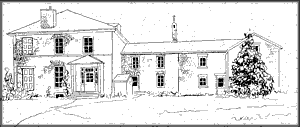 #8 - Denaut House, 1849 - Walter Denaut was a prosperous and widely-renowned mill owner (see #9), postmaster, general merchant and politician (first reeve of Bastard and S. Burgess
Twsp.). Befitting his wealth and status, he built this impressive 2 storey mansion of rough-masoned stone, complete with a wing of brick containing the servants’ quarters. During an age and stage when much of the local forest had been cleared, the Denauts could look from their knoll-top residence over their mill, their village and their lake (Upper Beverley Lake / mill pond). An unusual feature of this magnificent home is the use of casement style of window in which the two frames or sashes holding the panes of glass open outward from hinged attachments along the sides, like twin doors. To retain symmetry, notice the two false windows to the left side of the south façade. Delta peers and Ottawa potentates were among the many guests who were welcomed by Walter and Julia at the threshold of their grand main entrance. #8 - Denaut House, 1849 - Walter Denaut was a prosperous and widely-renowned mill owner (see #9), postmaster, general merchant and politician (first reeve of Bastard and S. Burgess
Twsp.). Befitting his wealth and status, he built this impressive 2 storey mansion of rough-masoned stone, complete with a wing of brick containing the servants’ quarters. During an age and stage when much of the local forest had been cleared, the Denauts could look from their knoll-top residence over their mill, their village and their lake (Upper Beverley Lake / mill pond). An unusual feature of this magnificent home is the use of casement style of window in which the two frames or sashes holding the panes of glass open outward from hinged attachments along the sides, like twin doors. To retain symmetry, notice the two false windows to the left side of the south façade. Delta peers and Ottawa potentates were among the many guests who were welcomed by Walter and Julia at the threshold of their grand main entrance.
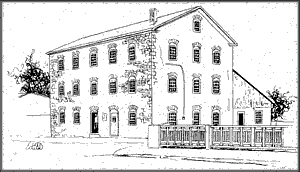 #9 - Delta Mill, circa 1810 - In 1810, William Jones and Ira Schofield had construction start on a 3½ storey automatic grist mill based on the design of American inventor Oliver Evans. Masoned from local stone and wood, it was positioned in an artificial channel and had the unusual design of acting as its own dam. The mill is an excellent example of Georgian architecture, built for an industrial purpose. #9 - Delta Mill, circa 1810 - In 1810, William Jones and Ira Schofield had construction start on a 3½ storey automatic grist mill based on the design of American inventor Oliver Evans. Masoned from local stone and wood, it was positioned in an artificial channel and had the unusual design of acting as its own dam. The mill is an excellent example of Georgian architecture, built for an industrial purpose.
It features 12-over-8 paned windows and the roof is supported by a 5-sided ridgepole hand-crafted from a single log. In 1817, this focal point of local
industry was described as “unquestionably the best (building) of its kind in Upper Canada.” Waterwheel power was replaced by turbine power in the 1860s, the turbines located in a stone addition to the original mill (the Turbine Shed). In 1960 the mill closed and in 1963 it was deeded to four trustees who later formed the non-profit Delta Mill Society. In 1970 it was designated a National Historic Site of Canada. It is the only surviving pre-1812 stone grist mill in Ontario. From 1999 to 2003, the Delta Mill Society had major restoration work done to the building and then added extensive interpretive signage and displays inside the mill.Working millstones were
added in 2010. Today the mill is open to the public from Victoria Day weekend to Labour Day and on special occasions throughout the year. In the 1850s, a building (today’s Drive Shed and Blacksmith’s Shop) was built just to the south of the Old Stone Mill. The first storey was used as a carriage shed and a brick second storey served as a town hall and general meeting place. The upper storey was removed in the
1960s and replaced with the current metal-clad upper storey.
Take a stroll along Court Street and visit Lower Beverley Lake Park and its excellent facilities for camping, picnicing, swimming, its areas for games and its trails for ambling or jogging. Savour the cool summer breeze from Lower Beverley Lake. So did weary travelers by the train-load who disembarked from the Sunday excursion of the B.W.& S.S.M.R.R. a century ago. The Brockville, Westport and Sault Ste. Marie Railway was a ribbon of steel that revolutionized travel and life in North Leeds back in 1888. But why was Sault Ste. Marie to be the end of the line? Ask a local citizen. Start a conversation.
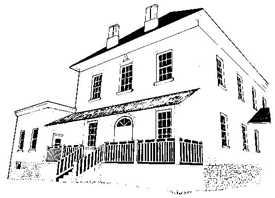 #10 - Old Town Hall, 1879 - The Old Town Hall was built in 1879/80 as a joint venture between the Municipality and the local Masonic Lodge. The bricks used for construction came from a brickyard in Delta run by Jasper Russel. The Lodge occupied the 2nd floor with the main floor serving many functions, including a courthouse and jail (in the basement), the municipal offices, a community theatre and as a general community hall. Panic ensued in February 1888 when the building caught fire. But the local citizens rallied. Men, women and children formed a bucket line to douse the flames and saved the building. In 1979, the building was vacated by the Municipality and the Masonic Lodge. In 1994, it was purchased by the Delta Mill Society for use as offices and archival storage. For a time the Old Town Hall served as a museum while the Old Stone Mill was undergoing restoration. With renovations to the hall completed in 2013, the first floor has been returned to its original purpose as a community hall for Delta and area. #10 - Old Town Hall, 1879 - The Old Town Hall was built in 1879/80 as a joint venture between the Municipality and the local Masonic Lodge. The bricks used for construction came from a brickyard in Delta run by Jasper Russel. The Lodge occupied the 2nd floor with the main floor serving many functions, including a courthouse and jail (in the basement), the municipal offices, a community theatre and as a general community hall. Panic ensued in February 1888 when the building caught fire. But the local citizens rallied. Men, women and children formed a bucket line to douse the flames and saved the building. In 1979, the building was vacated by the Municipality and the Masonic Lodge. In 1994, it was purchased by the Delta Mill Society for use as offices and archival storage. For a time the Old Town Hall served as a museum while the Old Stone Mill was undergoing restoration. With renovations to the hall completed in 2013, the first floor has been returned to its original purpose as a community hall for Delta and area.
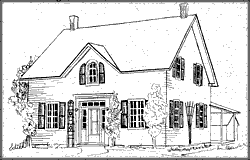 #11 - Johnston House, 1850s -This house is a fine example of a mid-19th century ‘Ontario Cottage’ with its rectangular shape, 1½ storeys and balanced façade. Note the front gable casement window with semi-circular head on the second storey and the pan-
eled entrance complete with rectangular transom and sidelights on the first
floor. Transoms with sidelights were common during that period of time because they were aesthetically pleasing and sym- metrical.As well, they were func- tional, allowing more natural light into a wide interior hallway in a pre-electric era. These architectural proportions, common in many mid-19th century homes of the Township, are associated with the Georgian style. This fine home of Richard and Caroline Johnston reflected their place in the social and economic life of this thriving community.Without doubt, this was the home of another prosperous Delta merchant in Upper Canada. #11 - Johnston House, 1850s -This house is a fine example of a mid-19th century ‘Ontario Cottage’ with its rectangular shape, 1½ storeys and balanced façade. Note the front gable casement window with semi-circular head on the second storey and the pan-
eled entrance complete with rectangular transom and sidelights on the first
floor. Transoms with sidelights were common during that period of time because they were aesthetically pleasing and sym- metrical.As well, they were func- tional, allowing more natural light into a wide interior hallway in a pre-electric era. These architectural proportions, common in many mid-19th century homes of the Township, are associated with the Georgian style. This fine home of Richard and Caroline Johnston reflected their place in the social and economic life of this thriving community.Without doubt, this was the home of another prosperous Delta merchant in Upper Canada.
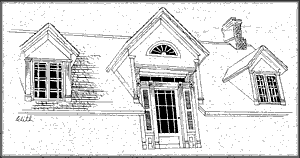 Stop #12 - Hicock House, circa 1845 - Recently and meticulously reno- vated to its original elegance,
this home is once again most impressive. Philo Hicock was the prosperous owner of a foundry busily serving the black metal needs of local industry and those farming the Delta hinterland. The front façade on the ground floor is graced by a central doorway with transom and sidelights. Providing an added touch of symmetry and grace are grand casement windows on each side. The second storey manifests 3 dormers, the centre one with elaborate wooden trim. Pause for a moment. Imagine the Hicock family enjoying the summer airs on their fine Regency porch while the local world beat a passing path to the Hicock Foundry and the myriad other services and functions of 19th century Delta. Stop #12 - Hicock House, circa 1845 - Recently and meticulously reno- vated to its original elegance,
this home is once again most impressive. Philo Hicock was the prosperous owner of a foundry busily serving the black metal needs of local industry and those farming the Delta hinterland. The front façade on the ground floor is graced by a central doorway with transom and sidelights. Providing an added touch of symmetry and grace are grand casement windows on each side. The second storey manifests 3 dormers, the centre one with elaborate wooden trim. Pause for a moment. Imagine the Hicock family enjoying the summer airs on their fine Regency porch while the local world beat a passing path to the Hicock Foundry and the myriad other services and functions of 19th century Delta.
You can find farther information on heritage life and on architecturally significant buildings of the Township of Rideau Lakes at any branch of the Rideau Lakes Union Library. Ask to peruse:
"Cranworth Chronicles" by Barbara Gibson, 1994 (South Burgess)
"Hub of the Rideau" by Sue Warren, 1997 (South Crosby Ward)
"My Own Four Walls" by Diane Haskins, 1985 (Bastard & S.Burgess Ward)
"South Elmsley in the Making" by James Kennedy, 1984
"Perspectives on a Wedge of Cheddar" by Doug Bond, 2017
...and the many resources illustrating heritage life in North Crosby to be found in the Westport Library and the Westport Museum.
Explore other communities and country roads of our Township of
Rideau Lakes with our Walking Tours and Driving Tours and our
Heritage Map published by our Municipal Heritage Advisory Committee.
|
 |
|
The Delta Mill Society
Box 172, Delta, Ontario K0E 1G0
Tel: 613-928-2584 (office)
Email: info@deltamill.org |
 |
|
 |

